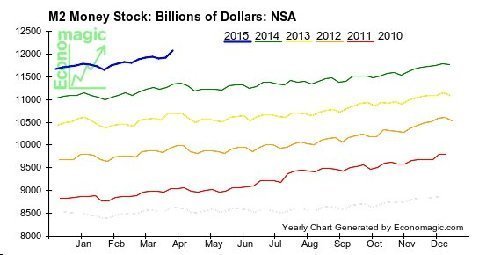There is a lot of confusion about the Fed, its interest-rate policy and the tools the Fed has at its disposal to create money and inflation. In other words, the tools to increase or decrease the money supply and increase or decrease interest rates.
Let me say from the onset that I am a big fan of Milton Friedman, but I am not a monetarist. Monetarism holds that an increase in the money supply will cause inflation and a decrease in money will cause deflation. It proposes a monetary rule that would establish a rate of increase of somewhere between 3% and 5% and that the Fed should hold that rate firm perpetually. Monetarism claims this will lead to low and stable prices. The theory is only half correct. Sometimes this theory works and sometimes it doesn’t.
Monetarism is accepted by most conservatives and libertarians, regardless that in today's economy it has been proved wrong. The Fed increased the money supply the most in history, some 3.5 trillion dollars over the last many years and should have produced soaring prices, an artificial boom and a crashing USD. But instead, disinflation set in along with stagnation, which have plagued the US for most of that period.
(For a further explanation of why that happened, see my commentary Why Prices Are Not Skyrocketing - PaulNathan.biz written in 2010.)
In the 70s, a period of rising inflation rates, the Fed fostered inflation by increasing the money supply dramatically and consistently. They did so in two ways, by buying notes and bills from banks, thereby injecting the banking system directly with money; and by lowering reserve requirements, freeing up money for banks to lend out. Under the Federal Reserve System, when banks loan out money, that money becomes leveraged as it's loaned to the tune of about 10-to-1. This leads to more money chasing fewer goods and to rising prices.
The key to creating inflation (if that's what a government wants) is to leverage money; to keep interest rates artificially low; and to do it progressively. In the 70s it worked like a charm. We saw the inflation rate rise progressively from 2% to 14% during the decade, causing havoc and destruction throughout the economy -- as Milton Friedman predicted it would. He fought almost single-handedly to educate the public that it was the Federal Reserve that caused inflation by artificially increasing the money supply. Friedman won that battle and between him, Paul Volker, and Ronald Reagan, inflation was defeated and has never returned in that form again. The inflation rate fell from 14% in 1980 to zero by the end of 2014.
The reason increasing the money supply didn't work to cause inflation in the last five years is because the money supply remained low. There was no bank lending. There was no leveraging of money. There has been de-leveraging instead. Banks took the money and refused to lend it out. They in effect, put it under the mattress. And borrowers were more concerned with paying down debt than taking on more debt. Credit expansion fell.
The money supply in circulation has remained very tame even in the face of huge money creation:

Only lately, has there been the beginning of what could be a meaningful acceleration of money and credit in circulation. What makes monetarism even more suspect as a working theory is that the upturn in the present money supply has only occurred as the Fed has discontinued its quantitative easing! The answer to why that is can be found in my above commentary, which predicted that no meaningful inflation would result from the Fed's new attempt to create inflation. It was at best a policy to try and fight deflation. At worst it has left a tinder box of money that potentially could ignite and explode into real inflation if not neutralized. But, any way you look at it, monetarism did not do what it was expected to do.
I have always argued the virtues of a gold standard and the classical monetary theories of Ludwig von Mises as the best way to promote a monetary system of integrity. But unlike gold bugs, I have argued that where gold may be a good long term investment, a return to the gold standard as a monetary system is way too premature at this time in this particular economy. In fact, if the gold bugs would have gotten their way and decreased the money supply and raised interest rates in the face of massive de-leveraging, they would likely have crashed the economy, the dollar, and the monetary system they so much want to improve.
There was a time, and will likely be a time again, when such hard money policies can be employed -- but it is not today. Today, we are still in the de-leveraging stage, not just here in the United States, but throughout the world. The world-wide deflationary/recessionary bias holding down growth is our main enemy, and our main focus is to put into place those policies that create stability and allow the economy and the monetary system to heal. Only then will growth normalize. Many of those policies are non-monetary in nature. They consist of regulatory and tax reforms. For the first time in five years there are preliminary signs that a return to normalization may be taking place.
I've argued that the Fed's Quantitative Easing -- which is the buying of bonds -- is at best anti-deflationary, but impotent in the attempt to raise prices. The following chart of the velocity of money should make that point eloquently.

If inflation is too many dollars chasing too few goods, we are nowhere near that point today. The velocity of money is and has been flat on its back for five years now. The thought of the Fed raising interest rates in the world we live in today would be dangerous in my opinion. There is no reason not to wait until we see the economy growing, prices rising across the board, and interest rates rising of their own accord due to real demand for money and inflationary concerns. That would be the time to fight inflation. It would be reasonable as things improve to follow the market and raise short-term interest rates as a market oriented response to rising long term rates.
So, today it is not monetarism that we need, nor the gold standard, nor edicts and decrees from government or the Federal Reserve. The monetary policy we need is a free market monetary policy. If you believe that free markets are a reliable source of information about the value of money and the health of the economy, then there should be no reason to artificially impose higher interest rates on society.
Remember, the Fed is out of the market. They are not buyers of new bonds, notes, or mortgages. Rates today are market rates, and they are among the lowest rates in history. There is no US monetary policy at work to attempt to artificially hold down rates as was the case over the last five years. What you see is what you've got. And the market is saying loud and clear that we still have historically low demand for money and commodities, and a historically high demand for safety.
In my view the decision to raise rates is premature. Following the markets is the best monetary rule I know in today's world.
It’s elementary my dear Yellen.
